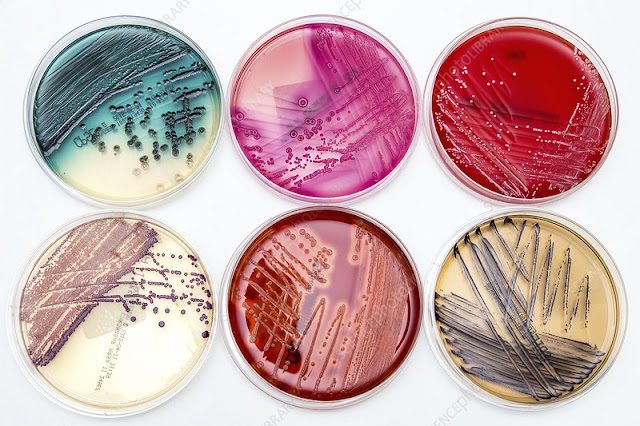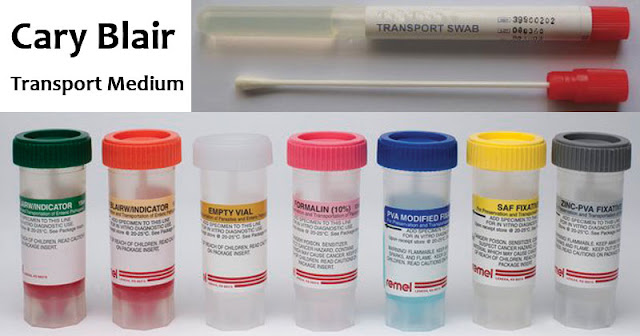CULTURE MEDIA
DEFINITION:
Culture media are artificially prepared substances which provide the basis for the growth of bacteria or microorganisms.
REQUIREMENTS FOR MAKING CULTURE MEDIA:
An ideal culture media must contain the following ingredients:
- Water
- Source of carbon
- Source of nitrogen
- Mineral salts
- Vitamins
- Specific substances according to the need of particular pathogens like; blood, egg, serum, ascitic fluid.
COMMON CONTENTS OF CULTURE MEDIA:
1. Peptone:
These are water soluble products obtained from the digestion of proteins. These proteins can be of plant, soya or meat origin. Proteins are digested by either acids or proteolytic enzymes to yield peptones, proteose peptones, peptides and amino acids. Peptone provides the nitrogen.
Proteins………………………..>Amino acids, peptides, peptone, protease
2. Agar:
This agent is used for the solidification of culture media as the gelling temperature of agar is very low while melting temperature is very high. So it withstands the temperature of autoclave and does not melt.
Agar is obtained from the plant known as sea weeds. Sea weeds are red purple algae.
Agar is a polysaccharide occurring mainly in two forms, agarose and agaropectin. Agar powder should be dry, inert and pure.
3. Meat extract:
This is commercially available and is also known as Lab Lamco powder. This is a source of amino acids and also essential growth vitamins and mineral salts like phosphates and sulphates.
4. Yeast extract:
It is obtained from the common backer’s or brewer’s yeast. This is a growth stimulant.
They are essential requirement for bacterial enzyme activity. Sulphates and phosphates are required as sources of sulphur and phosphorous.
5. Carbohydrates:
It provides energy and sources of carbon to bacteria. It also helps in differentiation of bacteria, for example lactose is added in MacConkey agar and Deoxycholate citrate agar to differentiate enterobacteria.
6. Water:
This is essential for the growth of all microorganisms. Deionised or distilled water must be used in the preparation of culture media.
CLASSIFICATION OF CULTURE MEDIA
BASED ON PHYSICAL STATE
- Solid Media eg. Blood agar, Chocolate agar
- Semi Solid Media eg. Stuart’s transport medium, Carry blair medium
- Liquid Media eg. Peptone water, Glucose broth
BASED ON OXYGEN SUPPLY
- Aerobic media eg. Nutrient agar, Blood agar
- Anaerobic media eg. Thioglycolate broth, Robertson’s cooked meat medium
BASED ON FUNCTION
- Simple media
- Complex media
SIMPLE/BASAL MEDIA:
- These are the basic and simple media used for the growth of microorganisms.
- Peptone water – 1% peptone + 0.5%NaCl + distilled water.
- Nutrient broth – peptone water + 1% meat extract.
- Nutrient agar – nutrient broth + 2-3% agar. It is the most common medium in routine diagnostic laboratories.
- If the concentration of agar is reduced to 0.2-0.5%, semisolid medium is obtained which enables motile organisms to spread.
COMPLEX MEDIA:
1.GENERAL PURPOSE MEDIA
These media are capable of detecting most aerobic and facultative anaerobic organisms eg. Sheep blood agar used for isolation of microorganisms directly from specimens.
- Taurocholate Broth
Alkaline Peptone Water
Glucose Broth
2. ENRICHED MEDIA:
In these media, substances such as blood, serum or egg are added to basal medium. e.g. Blood agar
- Chocolate agar
- Loeffler’s serum agar
- Lowenstein-Jensen medium
3. ENRICHMENT MEDIA:
Substances which have a stimulating effect on the bacteria to be grown or an inhibitory effect on those to be suppressed are added to a liquid medium, the result is an absolute increase in the numbers of the wanted bacteria relative to the other bacteria. Such media are called enrichment media.
- Selenite F broth for dysentry bacilli & Salmonella
- Tetrathionate broth for typhoid bacilli
4. SELECTIVE MEDIA:
As in above case, if the inhibiting substances are added to a solid medium, it enables greater number of the required bacteria than the other bacteria. Such media are known as selective media. e.g.
- Deoxycholate citrate medium – dysentery bacilli
- Wilson &Blair medium - Salmonella
- TCBS medium – Vibrio cholera
5. INDICATOR MEDIA-
These media contain an indicator which changes colour when a bacterium grows in them. e.g.
- Sulphite in WB medium
- Potassium tellurite in McLeod medium
- Neutral red in MacConkey medium
6. DIFFERENTIAL MEDIA –
Media which have substances incorporated in it, enabling them to bring out differing characteristics of bacteria & helping to distinguish between them, are called differential media. e.g. MacConkey medium, TCBS medium.
7. TRANSPORT MEDIA:
In case of delicate organisms (like gonococci) which may not survive the time taken for transporting the specimen to the laboratory or when they (such as dysentery or cholera organisms in feces)may be overgrown by nonpathogenic bacteria, special media are devised for transporting the specimens. These are known as transport media.
- Stuart’s medium for gonococci
- Alkaline peptone water & VR medium for cholera bacilli
- Buffered glycerol saline medium for enteric bacilli
- Carry blair medium for enteric bacilli
- Sugar fermentation medium
Triple Sugar Iron Agar (TSI)
8. SUGAR MEDIA -
- The usual sugar media consist of 1% sugar in peptone water along with an appropriate indicator.
- A small tube (Durham’s tube) is kept inverted in the sugar tube to detect gas produced by bacteria.
- For organisms which are exacting in their growth requirements, Hiss’ serum sugars are used which contain 3% serum.
9. ANAEROBIC MEDIA:
- These media are used to grow anaerobic organisms.
- These media are nutritionally enriched and prereduced of molecular oxygen for better growth of anaerobes from patient specimens.
- e.g. Robertson’s cooked meat medium and thioglycolate broth.
- With availibilty of commercial dehydrated culture media, the process of media making has become simpler and its quality more uniform.


